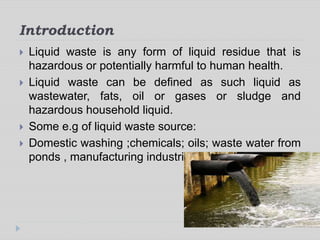Some Of Reclaim Waste
Some Of Reclaim Waste
Blog Article
Reclaim Waste Things To Know Before You Buy
Table of ContentsReclaim Waste Fundamentals ExplainedSome Ideas on Reclaim Waste You Should KnowFacts About Reclaim Waste Uncovered4 Simple Techniques For Reclaim WasteUnknown Facts About Reclaim Waste
Check out the kinds, occurrences, and types of fluid waste. Domestic sewage waste refers to the waste and items from a domestic septic system. This sort of waste is produced by people in homes, colleges, and various other buildings. This only includes septic storage tanks that have a drain field. The proper administration and disposal of residential sewage waste need fluid waste to be moved to a sewer therapy plant where the appropriate techniques and tools are related to purify and throw away waste.
Industrial waste often consists of prospective hazards, such as flammable products or a mix of liquid and strong waste items, and requires a much more sophisticated and detailed disposal process. The disposal of industrial waste generally entails the filtration of waste prior to transport to ensure risk-free and correct disposal. Hazardous waste is created from byproducts and runoff of commercial procedures and manufacturing.
This type of waste can not utilize the very same sewage administration transport or procedures as septic or commercial liquids. The industrial waste monitoring procedure calls for the inspection and testing of fluid waste prior to it undertakes the disposal process (liquid waste disposal melbourne). Runoff waste is the liquid waste that comes from overflow and excess stormwater in extremely inhabited locations or cities
Runoff waste can create contamination and flooding if not dealt with properly. Find out more about drain cleansing and waste administration. Guaranteeing correct waste administration can stop calamities and reduce ecological harm. Both individuals in residential settings and experts in industrial or manufacturing markets can gain from recognizing the procedures and regulations of fluid waste monitoring.
5 Simple Techniques For Reclaim Waste
Get in touch with PROS Services today to discover our waste monitoring and disposal solutions and the proper means to look after the liquid waste you produce.
(http://www.place123.net/place/reclaim-waste-laverton-north-vic-australia)Do you recognize what occurs to your water when you pull the plug, flush the bathroom or drain the washing equipment? No? Well, it's worth knowing. This so-called 'wastewater' is not only an important resource but, after therapy, will be released to our land, rivers or the sea. Made use of water from toilets, showers, baths, kitchen area sinks, laundries and commercial processes is called wastewater.

water used to cool down machinery or tidy plant and devices). Stormwater, a form of wastewater, is overflow that moves from farming and metropolitan areas such as roof coverings, parks, gardens, roads, paths and seamless gutters into stormwater drains pipes, after rainfall. Stormwater moves untreated directly to neighborhood creeks or rivers, at some point reaching the ocean.
What Does Reclaim Waste Do?
In Queensland, a lot of wastewater is dealt with at sewage therapy plants. Wastewater is carried from domestic or industrial websites with a system of sewage systems and pump stations, recognized as sewage reticulation, to a sewer treatment plant.
The Division of Natural Resources advises city governments regarding handling, operating and preserving sewage systems and therapy plants. In unsewered locations, city governments might require householders to set up private or household sewer therapy systems to deal with residential wastewater from commodes, kitchens, shower rooms and laundries. The Division of Natural Resources authorizes the use of home systems when they are verified to be effective.
In some new neighborhoods, treatment of some stormwater to remove trash, sand and gravel has begun making use of gross contaminant traps. Wastewater therapy takes place in 4 phases: Gets rid of solid issue.
Wastewater then flows into huge storage tanks where solids work out and are removed as sludge. Grease and residue are skimmed from the surface. Makes use of little living organisms referred to as micro-organisms to damage down and eliminate staying liquified wastes and great fragments. Micro-organisms and wastes are included in the sludge. Gets rid of nitrogen and phosphorus nutrients that could create algal blooms in our rivers and endanger marine life.
6 Simple Techniques For Reclaim Waste
Nutrient elimination is not offered at all sewage therapy plants because it needs pricey specialized equipment. It is becoming a lot more common in Queensland. Clear fluid effluent created after treatment might still have disease-causing micro-organisms. If this effluent is launched right into waterways such as rivers or the sea, the micro-organisms will at some point pass away out.

The majority of wastewater streams right into the sewage system. Under the Act, neighborhood federal governments provide authorizations and licences for environmentally appropriate tasks (Periods) entailing wastewater launches that may have a neighborhood effect.
Not known Details About Reclaim Waste
Surveillance gives valid info about water high quality and this website can verify that permit problems are being met. The details obtained through monitoring supplies the basis for making water top quality decisions.
Report this page